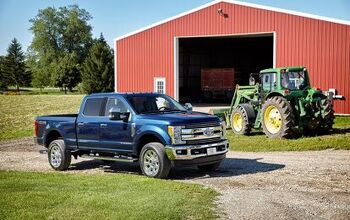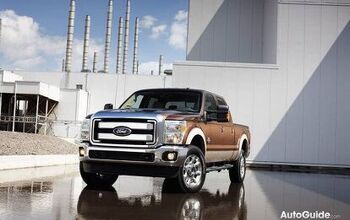2011 Ford F-Series Super Duty: First Drive
Since Ford spun off the Super Duty into a completely separate line from it’s regular F-series, it’s set the bar for the class in many respects. But as we all know, the competition doesn’t exactly stand still, so to keep ahead and continue capturing the biggest slice of the market, updates are essential. For 2011, the folks from Dearborn have given the Super Duty a substantial makeover, including styling updates, new powertrain options, revised suspension, revamped interior and additional feature content not previously offered.
FAST FACTS
| 1. Along with a new interior and exterior, the 2011 F-Series Super Duty gets new engines, including a 6.2L gas V8 with 385-hp and 405 ft-lbs or the big dog 6.7L PowerStroke diesel with 390-hp and 735 ft-lbs. |
| 2. With a max payload rating of 6,520 lbs, F-350 models are rated to tow 21,600 lbs, while F450 models can now tow 24,400 lbs. |
| 3. 2011 Super Duty trucks are also available as F-550s, though strictly as chassis cabs for commercial use. |
| 4. An optional 4.2-inch LCD screen (mounted between the speedometer and tachometer) allows the driver to receive information regarding fuel economy and towing performance. |
| 5. Standard and optional features include Hill Start Assist, Hill Descent Control, Trailer Sway Control, Trailer Brake Control and, of course, Ford’s AdvanceTrac with Roll Stability Control. |
In terms of models and configurations, the ’11 Super Duty is offered in 12 different models for ‘personal use’ buyers, beginning with the F-250 XL at $28,020, all the way up to the F-450 King Ranch, which lists at a not inexpensive MSRP of $62,375. Between them you have Lariat and King Ranch models of the F-250; XL, Lariat and King Ranch Editions of the F-350; plus the same trim levels on the biggie F-450. Regular and Supercab configurations are offered on all XL and XLT trims, while Lariat and King Ranch Editions are crew cab only.
NEW LOOK INSIDE AND OUT
Like many of Ford’s current offerings, quality control and workmanship are vastly improved, especially if you compare the current Super Duty with its original ’99 model year namesake. For 2011, these rigs adopt an even bolder front-end treatment, with a more pronounced grille, smoother headlight assemblies and a ‘power dome’ hood. The result is a more integrated appearance than on the 2008-10 editions, which somehow looked as though the front-fascia was essentially an afterthought.
Other noteworthy features include a built in step for the tailgate and a factory available Tough a Bed, a military grade spray on bed liner that is thinner and more evenly covers the floor and sides of the box compared to traditional aftermarket offerings.
Inside is perhaps where you notice the biggest difference between the ’11 and last year’s truck – materials and ergonomics are truly first rate. Gauges are easy to read and the center stack on higher end models (Lariat and King Ranch) is easy to operate, despite a far greater use of touch screen features than before. Because Super Duty trucks, unlike their smaller F-150 counterparts, retain a column shifter regardless of the trim level, Ford’s interior team was able to develop a new flow through console with multiple storage bins and rear HVAC controls. The bin beneath the front center armrest is simply huge. Sound deadening is also improved and there’s no question that in terms of seat comfort and convenience, the 2011 Super-Duty is by far the most refined yet.
ALL NEW 6.2L GAS V8 AND POWERSTROKE 6.7L V8 FOR ADDED TOWING
One of the most significant developments is the updated drivelines – the new 6.2-liter gasoline V8 and a new 6.7-liter diesel V8 with a 6R140 heavy-duty six-speed automatic slushbox (which replaces the previous 5R110 five-speeder). The gas V8 is a welcome improvement over the old 5.4. It’s rated at 385 horsepower at (a relatively high) 5500 rpm; with maximum torque of 405 ft-lbs coming at a fairly peaky 4500 revs. Like many modern Detroit V8s, it’s E85 compatible and boasts improved crankcase breathing over the old 5.4, also using oil jets to coat the pistons and reduce cylinder bore temperatures. With dual spark plugs for each cylinder and phased cam timing for the intake and exhaust valves, it delivers decent throttle response through a wider rev range than the 5.4, plus thanks to the gearing on the six-speed automatic (first gear is a relatively short 3.97:, with overdrive a freewheeling .067:1), is smooth and refined at virtually all engine speeds.
Ford has repeatedly stated that the new engine gets around 15 percent better fuel economy than the old 5.4, but has yet to list any official figures. Based on our evaluation, you’ll likely get around 9-10 mpg in town and a maximum of 16 mpg on the open road, without towing a trailer.
However, for many would be Super Duty customers (97 percent according to Ford) towing is a pre-requisite and as a result, many of said buyers are likely to opt for the PowerStroke diesel engine. For 2011, a new 6.7-liter version replaces the previous Navistar sourced 6.4 unit. The new motor uses a compacted graphite iron block, designed to reduce weight while maintaining strength; high pressure common rail fuel system and a unique intake and exhaust configuration, with a single turbocharger housing that contains a dual sided compressor wheel, designed to maximize torque delivery while taking up less space under the hood.
Rated power and torque is impressive by all accounts – 390 horsepower at just 2800 rpm and a staggering 735 ft-lbs at just 1600. This has allowed Ford to give the Super Duty a maximum payload capacity of 6,250 lbs and overall towing capacity of 24,400, which is currently the highest in the segment. Compared with the gas V8, throttle response is instant at low rpm, while accelerating onto freeways and at cruising speeds, the new PowerStroke feels almost as smooth and refined as the gas engine.
Although gearing in the six-speed automatic transmission is identical, the transmission works just as well with the diesel, there’s no hunting or bogging. Ford equips PowerStroke Super Duty trucks with a standard 3.3:1 rear axle ratio, though 3.55, 3.73 and (for the towing diehards) 4.30 ring and pinion options are available. In terms of fuel economy, Ford again claims best in class, but hasn’t released any official mpg figures – again, based on our evaluation of a PowerStroke F-350 with the 3.73 axle; we found it will gulp a gallon of ultra low sulfur diesel every 11 or so miles in town and around 16 on the highway with an un-laden bed.
MUCH IMPROVED RIDE QUALITY, GREAT NEW FEATURES
One area where we did note significant improvements was in ride and handling. Although it still uses a leaf-sprung rear, retuned shock absorbers and revised rear spring rates have done wonders to quell the bumpy ride so common on trucks in this class. Even on really rough pavement, with no weight out back, the 2011 Super Duty remains remarkably composed. Thanks to revised steering geometry, the new truck also turns better with more direct response and improved on-center feel, in similar vein to the current F-150.
Thanks to additional features such as the first factory mounted fifth wheel chassis coupling (with built-in electrical connector mounted on the side of the bed), standard trailer sway control (that can adjust throttle and braking input when towing), plus Hill Start Assist and Descent control, (which come in very useful when handling rough terrain), the 2011 Super Duty is packed with useful and capable features. And on 4×4 models, an electronically locking differential, especially when combined with the 6.7-liter diesel, makes this rig virtually unstoppable out in the boonies.
Also new for 2011 is a Live Drive PTO (Power Take Off), which allows auxiliary equipment like snowplows or salt spreaders to be powered through the transmission.
THE VERDICT
Although Ford drew criticism this past decade for quality and reliability niggles on its Super Duty trucks (notably fuel system failures on the old 6.0-liter PowerStroke); based on our evaluation, the 2011 version has made those issues a distant memory. The new Super Duty’s combination of power, capability and refinement have once again raised the bar for the segment and at this juncture, it looks like GM and Ram have a bit of homework to do in order to match it.
RELATED READING
2010 Dodge Ram Heavy Duty: First Drive
2009 Ford F-150
2009 GMC SIERRA
2009 Dodge Ram
2009 Chevrolet Silverado
2010 Toyota Tundra 4×4 Double Cab 4.6L Review
2010 Nissan Titan Review
LOVE IT
- Torque (PowerStroke diesel)
- Refinement
- High standard of equipment
LEAVE IT
- Size
- Fuel economy still not that great
- Can be pricey
More by Huw Evans




































Comments
Join the conversation